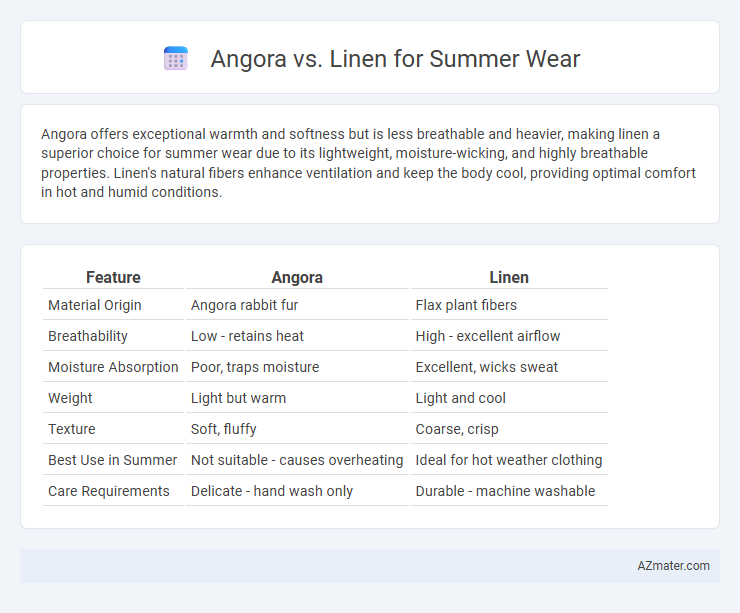Angora offers exceptional warmth and softness but is less breathable and heavier, making linen a superior choice for summer wear due to its lightweight, moisture-wicking, and highly breathable properties. Linen's natural fibers enhance ventilation and keep the body cool, providing optimal comfort in hot and humid conditions.
Table of Comparison
| Feature | Angora | Linen |
|---|---|---|
| Material Origin | Angora rabbit fur | Flax plant fibers |
| Breathability | Low - retains heat | High - excellent airflow |
| Moisture Absorption | Poor, traps moisture | Excellent, wicks sweat |
| Weight | Light but warm | Light and cool |
| Texture | Soft, fluffy | Coarse, crisp |
| Best Use in Summer | Not suitable - causes overheating | Ideal for hot weather clothing |
| Care Requirements | Delicate - hand wash only | Durable - machine washable |
Introduction to Angora and Linen Fabrics
Angora fabric, derived from the Angora rabbit's soft, silky wool, offers exceptional warmth and a lightweight feel, making it a luxurious choice for cooler summer evenings. Linen, crafted from flax fibers, is highly breathable and moisture-wicking, ideal for maintaining comfort in hot, humid conditions. Both fabrics provide unique benefits for summer wear, with Angora emphasizing softness and insulation, while linen ensures breathability and durability.
Breathability: Which Fabric Keeps You Cooler?
Linen offers superior breathability compared to Angora, making it ideal for hot summer days due to its loose weave and natural moisture-wicking properties that enhance airflow and evaporate sweat quickly. Angora, derived from rabbit fur, provides excellent warmth but lacks breathability, often trapping heat and causing discomfort in high temperatures. For optimal cooling and comfort, linen remains the preferred fabric in summer wear.
Moisture-Wicking Abilities: Angora vs Linen
Linen outperforms Angora in moisture-wicking abilities due to its highly breathable, loosely woven fibers that effectively absorb and evaporate sweat, keeping the skin cool and dry during summer. Angora, derived from rabbit fur, offers excellent insulation but retains more moisture, making it less ideal for hot, humid conditions. For optimal summer wear, linen's superior moisture management ensures enhanced comfort and reduced dampness compared to Angora.
Comfort and Feel Against the Skin
Angora offers exceptional softness and warmth but can feel too insulating for summer, potentially causing discomfort in hot weather. Linen is highly breathable and lightweight, allowing air circulation that keeps the skin cool and dry during summer months. Its natural moisture-wicking properties make linen the preferred fabric for comfort and freshness in warm climates.
Weight and Texture: Lightness for Hot Days
Angora offers a unique softness and warmth but is heavier and less breathable compared to linen, making it less ideal for hot summer days. Linen's lightweight, highly breathable texture allows for superior moisture-wicking and airflow, ensuring comfort in high temperatures. Choosing linen ensures optimal lightness and coolness, essential for summer wear.
Durability and Longevity Comparison
Angora offers exceptional softness but tends to have lower durability compared to linen, making it more prone to pilling and wear over time. Linen fibers exhibit high tensile strength and excellent resistance to abrasion, ensuring long-lasting performance in summer garments. For summer wear requiring durability and longevity, linen is a superior choice due to its robust fiber structure and ability to maintain integrity through repeated use and washing.
Style and Versatility for Summer Outfits
Angora offers a luxurious, soft texture that adds a cozy yet elegant touch to summer outfits, making it ideal for cooler summer evenings or breezy coastal settings. Linen provides unparalleled breathability and a crisp, natural look, enhancing versatility for casual daywear and chic, minimalist summer styles. Both fabrics complement various summer wardrobe staples, with linen excelling in lightweight layering and Angora lending a refined, tactile element to stylish ensembles.
Hypoallergenic Qualities and Skin Sensitivity
Linen is highly favored for summer wear due to its natural hypoallergenic properties and exceptional breathability, making it ideal for sensitive skin prone to irritation. Angora, although soft and warm, can sometimes cause allergic reactions or sensitivity because it is a fine wool fiber that may irritate delicate skin. Choosing linen ensures moisture-wicking benefits and a cooler feel, reducing the risk of heat-induced skin discomfort and allergies during hot weather.
Eco-Friendliness and Sustainability Factors
Angora fibers are biodegradable and renewable, but the ethical concerns surrounding animal welfare and the intensive care required for angora rabbits can impact sustainability. Linen, derived from flax plants, is highly eco-friendly due to its low water usage, minimal pesticide requirements, and full biodegradability, making it an excellent sustainable choice for summer wear. The cultivation and processing of linen produce a smaller carbon footprint compared to animal-based fibers like angora, positioning linen as a greener textile option overall.
Care and Maintenance Tips for Summer Wear
Angora requires gentle hand washing with cool water and mild detergent to prevent fiber damage and matting, while linen can withstand machine washing but should be laundered in cold water to maintain fabric integrity and avoid shrinkage. Both fabrics benefit from air drying rather than tumble drying to preserve their breathability and texture, with Angora needing extra care to prevent felting. Regular brushing of Angora garments helps maintain softness and remove debris, whereas linen garments should be steamed or ironed on low heat to reduce wrinkles and maintain a crisp appearance.

Infographic: Angora vs Linen for Summer Wear
 azmater.com
azmater.com